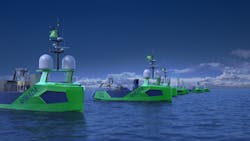Armada fleet to feature Sonardyne technologies
Offshore staff
YATELEY, UK – Ocean Infinity has contracted Sonardyne to provide acoustic communication and inertial navigation technologies for its Armada fleet of robotic vessels.
The vessels, initially measuring 21 m and 36 m (69 ft and 118 ft) long, will be able to perform offshore data acquisition and intervention in both shallow and deepwater regions. The vessels will use a range of underwater platforms, including remotely deploying AUVs and ROVs.
The company will deliver key sensor technologies for underwater platform navigation, tracking, control and communications, as well as ensuring uninterrupted surface navigation, even when global navigation satellite system (GNSS) services are degraded or denied.
The first tranche of the Armada vessels will be fitted with Sonardyne’s Ranger 2 Ultra-Short BaseLine (USBL) system augmented by the company’s Marine Robotics Pack. This combination is said to provide remote all-in-one tracking, communications and control capability for underwater deployed robotics so that even more operations can now be done from shore.
They will also be fitted with the company’s SPRINT-Nav hybrid navigation instrument, to provide continuous, uninterrupted navigational aiding to underpin safe remote operations, even if GNSS service is impaired due to their remote location or nearby infrastructure. In addition, the system produces profiled water column data, which is important during the deployment and recovery of subsea robots.
Wideband Sub Mini 6+ tracking transponders and SPRINT-Navs will also be fitted to the ROVs being deployed and operated by the Armada fleet.
Equipment delivery for the first wave of the Armada vessels is expected by the end of this year. Further deliveries will be made through 2021.
Ocean Infinity expects the first Armada vessel to be delivered in 2021. The fleet will be controlled and operated by mariners via satellite communication from onshore control facilities in Austin, Texas, and Southampton, England.
12/09/2020
